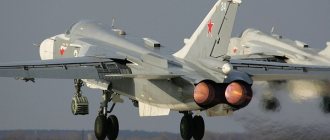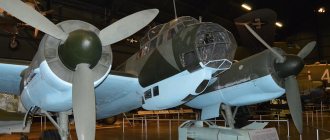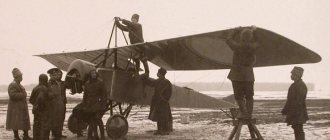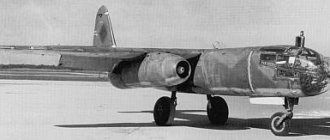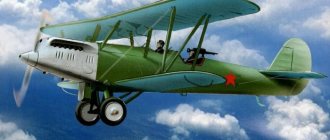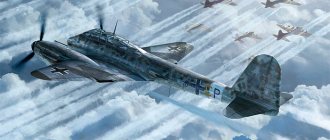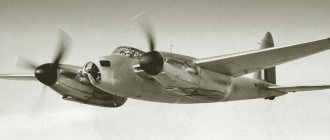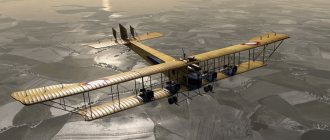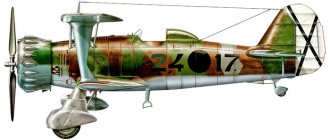Airliner and medium bomber
| Ju 86 | |
| Royal Hungarian Air Force Ju 86 K-2 showing Junkers doppelflügel | |
| Role | Bomber, airliner, reconnaissance aircraft |
| Manufacturer | Junkers |
| Designer | Ernst Zindel [1] |
| First flight | November 4, 1934 |
| Introduction | 1936 |
| Retired | 1958 (Swedish Air Force) |
| Status | retired |
| Primary user | Luftwaffe |
| Number of built | ~ 900 |
Junkers Ju 86
was a German monoplane bomber and civilian airliner developed in the early 1930s, and used by various air forces on both sides during World War II.
The civilian model Ju 86B
could carry ten passengers. Two were delivered by Swissair and five by Deutsche Luft Hansa. In addition, the only civilian Ju 86Z was delivered to the Swedish company AB Aerotransport. [2]
Design and development [edit]
In 1934, Junkers and Heinkel received the specification for a modern twin-engine aircraft capable of operating both as a high-speed airliner for the German airline Luft Hansa and as a medium bomber for the nascent Luftwaffe. Five prototypes were ordered from each company; Junkers Ju 86 and Heinkel He 111. [3]
The Junkers design was a low-wing, twin-engine monoplane of all-metal construction with reinforced skin. Unlike most previous Junkers designs, it eschewed the typical corrugated skin in favor of a smooth metal skin that helped reduce drag. The ship was fitted with a narrow gauge conventional undercarriage with a retractable main landing gear with a fixed tail wheel, twin fins and rudders. It was to be powered by Junkers Jumo 205 diesel engines, which, although heavy, gave better fuel consumption than conventional petrol engines. [3] [4]
Ju 86 cross-sectional diagram
The only remaining complete Junkers Ju 86 (1976)
The wing design used characteristic elements
Junkers
doppelflügel
, similar to those on the Junkers Ju 52. They were hinged under the trailing edge of the wing, with the outer part on each side functioning as ailerons, and the inner part as flaps. The bomber had a crew of four; pilot, navigator, radio operator-bombardier and gunner. Defensive armament consisted of three machine guns located in the bow; in a dorsal position; and in a retractable ventral position. The bombs were carried vertically in four compartments of the fuselage behind the cockpit. [5]In the airliner version, the bomb bays were replaced with seating for ten passengers, and the fuel tanks were moved from the fuselage to the wings. [6]
The Jumo 205s were missing when the first airframe prototype was completed. Instead, the Ju 86ab1 bomber was powered by Siemens SAM 22 radial engines and first flew on 4 November 1934. [3] The second prototype, also a bomber, flew in January 1935. The third Ju 86, the first civilian prototype, flew on April 4, 1935. [6] Pre-production military and civilian aircraft began production in late 1935, [6] full production of the Ju 86A-1 bomber began in April 1936. Ju 86D with modified tail cone to improve stability. [7]
Early use of the Jumo-engined Ju 86 bomber in the Spanish Civil War found it inferior to the He 111 and its diesel engines unsuitable for rough handling during combat; [8] and production plans were reduced. One Ju 86 has already been converted to use radial engines as a test bed for possible export versions, and this has shown improved reliability. Production switched to a version powered by the BMW 132 Ju 86E, which continued in production until 1938.[9]
Hungarian Ju-86K-2, 1941
Civilian variants introduced in 1936 were designated Ju 86Z in three different models, differing in engines. The Ju 86Z-1 with the Jumo engine (matching the former B-0 or C-1) was sold to Swissair (one), Airlines of Australia (one) and LAN-Chile (three). The BMW 132H-powered Ju 86Z-2 was sold to DLH (two) and the paramilitary company Manchukuo Air Transport (five or more). The Pratt & Whitney R-1690 Hornet-engined Ju 86Z-7 was delivered to AB Aerotransport (ABA) of Sweden (one, for use as a mail carrier), Lloyd aéreo Boliviano (three), and South African Airways - SAA - (17). The ABA aircraft was later transferred to the Swedish Air Force, with which it served, under the designation Tp 9, until South African Airways' original intention in 1958 was to have its 86S Ju powered by 745 hp. Rolls-Royce Kestrels. Six SAA aircraft equipped with these engines were converted to Hornets before delivery, and the remainder were also equipped with Hornet engines.
Ju 86K
there was an export model, also built under license in Sweden by Saab as the B 3 with (905 hp) Bristol Mercury XIX radial engines. Several aircraft remained in service with the Swedish Air Force until 1958. [10] Some were converted for radio interception. [eleven]
Junkers "Ju-86", Bomber
Junkers Ju.86
In 1933, the interaction of the Technical Department of the newly created Air Commissariat and Lufthansa in developing the requirements for a twin-engine aircraft combining the qualities of a medium bomber and a commercial aircraft for the so-called “blitz routes” of Lufthansa led to the creation of two projects that were destined to play an important role in the development of combat and civil aviation of the Third Reich in the pre-war years. In 1934, the main specifications were sent to Junkers in Dessau and Ernst Heinkel in Warnemünde. Their work ended with the creation of Ju.86 and He.111, respectively. In the spring, each of the companies received orders for five prototypes in both versions, first a combat aircraft, the next a civilian one, etc. The Ju.86 was a development of the single-engine Ju.60 and its variant Ju.160. It represented a departure from the traditional Junkers design with corrugated skin, a square-section fuselage and multi-spar wings. They were replaced by an oval fuselage and a two-spar wing with smooth skin. The first experimental Ju.86ab1 (#4901) was released within five months. Its production took 271,091 man-hours. The first flight took place on November 4, 1934 in Dessau - four months earlier than the first flight of the He.111a in Marien. From the very beginning, the new aircraft was designed for the new Jumo-205 aviation diesel engines, created at Junkers Motorenbau and being prepared for production in Kötchen. These six-cylinder two-stroke water-cooled diesel engines had a small specific power, but had a smaller cross-section. Since there were no flightable Jumo-205s yet, the first prototype aircraft was equipped with two Siemens SAM-22 engines - 9-cylinder air-cooled engines with two-blade fixed-pitch propellers. During the first flights of the Ju.86ab1, which did not yet have weapons, a number of shortcomings were revealed, the main one of which was poor response to the rudders. Longitudinal stability was insufficient. The plane was returned for modifications. At the same time, the upper and lower shooting positions were established. The upper turret was closed with a sliding canopy, and the lower one was a semi-retractable basket. The same modifications were made to the second experimental version of the Ju.86cb bomber, which featured a glass nose and a small manually controlled nose turret. Ju.86сb (D-ALAL #4903) became actually the second experimental aircraft, which made its first flight in January 1935. Initially, it had SAM-22 engines with three-bladed Hamilton variable-pitch propellers, and in March they were replaced with Jumo-diesels. 205C. At the same time, the second experimental Ju.86bа1 (D-ABUK #4902) was completed, immediately equipped with a Jumo-205С and flown in April 1935. The Ju.86bа1 became the first prototype of the civilian version and differed from the bomber only in the absence of defensive weapons and bomb racks (first installed on Ju.86сb). It was planned to accommodate 10 passengers in a somewhat cramped cabin with a width of only 1.5 m. By this time, a standard designation system for experimental aircraft - “ferzukh” - had been introduced. As a result, the aircraft received the designation Ju.86ab1, bа1 and cb, respectively — V1, V2 and V3. The second transport Ju.86-V4 (D-AREV #4904) was considered a prototype of the passenger Ju.86B. The first flight took place in May 1935. It was delivered to Lufthansa in the summer for testing on passenger routes. The aircraft was originally named Dresden and was later renamed Brocken. Then it was joined by the Ju.86-V2, but in December both aircraft were returned to Dessau. By this time, it became clear that the controllability of the Ju.86 in its current form could not be improved, and Junkers designers began to design a new wing of a larger area. It originally had straight, tapering edges. The narrowing of the trailing edge has now been reduced, so that the average chord of the wing has increased by a third, while the narrowing of the tips has, on the contrary, been increased. As a result, the Ju.86 received wings with a kink along the leading and trailing edges. Ju.86-V4 and V5 (D-AHOE #4905) received the same wing. The latter was considered a prototype for the production Ju.86A bomber and flew in August 1935. At the same time, the tail spike was replaced with a wheel, and a new form of radiators under the engine nacelles improved cooling. The V5 also featured a new nose section and a redesigned ventral basket.
Ju.86A series
Production of the combat and civilian versions of the aircraft began simultaneously at the Dessau plant at the end of 1935. The pilot batch consisted of 13 Ju.86A-0 and seven passenger Ju.86B-0. They began to roll off the assembly line in February 1936. Ju.86A-0 were sent to the Luftwaffe for military testing. At the end of spring, the first production Ju.86A-1 was released and entered KG.152 “Hindenburg”. Unlike the Ju.86-V5, the serial Ju.86A-1 received two Jumo-205C-4 engines with a takeoff power of 600 hp and 510 hp at nominal power. The fuselage set consisted of four spars connecting oval-shaped frames. Working skins were riveted to them. The wing had two spars and a working skin supported by stringers. The Junkers double wing flaps consisted of three sections. The outer section was the aileron. One of the features of the aircraft was a narrow landing gear, the struts of which were retracted using an electric motor. The crew consisted of four people: a pilot, a navigator, a radio operator and a gunner. The defensive armament of the Ju.86A-1 consisted of three MG-15 machine guns located in the bow turret, on the upper turret under the sliding canopy and in the lower basket. The fuselage provided for eight 100 kg bombs to be suspended vertically in separate compartments. The fuel supply consisted of 600 liters in gas tanks located in the engine nacelles. Additional tanks could be installed on the inside of the engine nacelles.
Ju.86B series
The pre-production batch included seven aircraft designated Ju.86B-0. On the last of them, instead of Jumo-205С diesel engines, they installed BMW-132Dс air-cooled engines. The aircraft as an export model received the designation Ju.86Z-2, although it entered Lufthansa under the registration D-ANUA Wasserkuppe. The first pre-production Ju.86B-0 (D-AXEQ Bückeberg) with diesel engines made the Dessau-Bathurst flight of 5765 km in 20 hours on August 22-23, 1936. The second Ju.86 was delivered to Swissaer in April 1936, where, under the registration NV-IXI, it was used on the night route Zurich-Frankfurt am Main. The remaining four Ju.86B-0s entered Lufthansa under the registration D-AHYP Schneekoppe, D-ALOZ Zugspitze, D-AQER Inselberg and D-AZAH Feldberg. Like the Ju.86-V4, the new Ju.86B-0 was used on lines from Berlin to Bremen, Cologne, Breslau, Dortmund, Gleiwitz, Hanover and Leipzig.
Ju.86C series
During 1937, Lufthansa's four Ju.86B-0s were joined by six Ju.86C-1s. They were also equipped with Jumo-205C diesel engines and were distinguished by an elongated rear fuselage, characteristic of the Ju.86D-1. Six Ju.86C-1s received registrations from Lufthansa: D-AKOI Kaiserstal, D-AQEA Schwinsland, D-ASOE Geselberg, D-AVOE Obersalzberg, D-AMYO Melibocus and D-AJUU Vogelberg. They were used by 18 Lufthansa airlines until 1940.
Ju.86D series
With the entry into service of the Luftwaffe Ju.86A-1 in the summer of 1936, the still unsatisfactory stability of the aircraft was revealed. To improve it, the tail section was lengthened. Tests were first carried out on the Ju.86A-0, designated Ju.86-V6. The aircraft also received increased fuel tank capacity to 900 liters at the request of RLM. With these changes, production bombers began to be called Ju.86D-1. In total, they managed to produce 20 Ju.86A-1. Both versions could be seen already in October 1936 during their first public demonstration in Bückeberg. At the end of 1937, five Ju.86D-1s were sent to Spain for testing as part of the Condor Legion. They later took part in the battles over Extremadura. By this time, the Luftwaffe no longer relied on the Junkers bomber. The He.111B showed complete superiority over the Ju.86D in almost all aspects, and the Jumo-205C diesel engines did not live up to expectations. They worked well under constant and long-term load, but did not tolerate changes in speed, which was required during combat maneuvering. An inexplicable mystery was the sharp drop in power at an altitude of more than 5000 m. This drawback could not be overcome before tests in Rechlin showed the unsuitability of installing the Jumo-205C on a bomber, despite the excellent efficiency of the engine. Junkers already had serious doubts about diesel engines, but for a different reason. Although the Ju.86's performance was not phenomenal, it was sufficient to attract interest abroad. But potential buyers did not like diesel engines due to their low power density compared to their gasoline counterparts. In addition, diesel engines required careful maintenance by specially trained personnel. As a result, after the release of the first Ju.86A-0, Junkers began to look for new engines.
Export models
The Swedes were the first to show serious interest in the Ju.86. After discussing with Junkers possible alternatives to the Jumo-205C, on June 30, 1936, an order was placed for one Ju.86A-1 with Pratt-Whitney S1E-G Hornet engines - 9-cylinder air-cooled, takeoff power 875 hp and 800 hp at face value The aircraft received the designation Ju.86A-1k at Junkers and was delivered to Sweden in December 1936. A month earlier, the Swedes ordered two more aircraft with Hornets. Since orders were also received for the civilian version of the aircraft, Junkers began to designate the combat version with the letter “K” and the civilian version with the letter “Z.” As a result, three Swedish aircraft with Hornet engines received the designation Ju.86K-1. One of them was later tested in Sweden on a ski chassis. In Swedish service the Ju.86K was called the B-3. Based on the test results, a pre-order for 37 aircraft followed, including 20 with air-cooled Bristol Pegasus-III engines, which since 1937 had been produced in Sweden under license from Nohab Fligmotorfabriker under the designation Mi-III. The engine had a power of 820 hp. The remaining aircraft were equipped with the 920-horsepower Pegasus-XII (Mi-XII) produced at Nohab. With Pegasus-III engines, the aircraft was designated Ju.86K-4 by Junkers, and B-3A by the Swedish Air Force, and with Pegasus-XII - Ju.86K-5 and B-3B, respectively. The order provided for the assembly of most of the bombers in Sweden under the supervision of Junkers employees at the Trollhatan factories - at the newly formed Svenska Aeroplan Aktibolaget (SAAB). Licensed production itself began in 1938 with an order for SAAB for 40 aircraft. Later the order was reduced to 16. The aircraft built in Sweden were designated Ju.86K-13 or B-3C and B-3D. The first had Pegasus-XXIV (Mi-XXIV) engines with a power of 980 hp, and the second had the imported Pegasus-XIX manufactured by PZL. The first Ju.86K-13 built on SAAB flew in August 1939, and the last one in January 1941. Then, on 15 Ju.86K-4s, the Pegasus-III engines were replaced with Pegasus-XXIV, and the aircraft were renamed B-3S-2 . The Ju.86K was destined to serve in the Swedish Air Force for a long time. In 1937, the bombers entered the F-1 air wing. Between 1944 and 1948 they served as torpedo bombers under the designation T-3 with the F-17 air wing at Ronneby. One or two aircraft were converted to train night fighters, they were equipped with an NFMk.19 locator, the same as on the Mosquito. In 1948, the remaining Ju.86Ks were converted into 12-seater passenger aircraft. The last of them was decommissioned in 1956. During 1937, small orders for bombers with Hornet engines were received from the Portuguese and Chilean governments. They were delivered in 1938 under the designation Ju.86K-6. Of the 10 Ju.86K-6s delivered to the Portuguese Air Force, they formed the “Groupa de Bombardeamento de Dia”. Another order came from the Austrian Air Force for 18 Ju.86E-2s, with which it was planned to re-equip two squadrons of the bomber squadron in Zeltweg. Only one Ju.86E-2 reached Austria before the Anschluss.
The largest order for Ju.86 came from Hungary. After considering the possibility of producing He.111 with licensed Gnom-Ron-14K Mistral Major engines, the Hungarians settled on purchasing Junkers bombers with the same engines. It was planned to equip two bomber units of their “secret” air forces with them. In 1936, the first order was issued for 24 Ju.86K-2, and a total of 66 bombers were purchased. Deliveries of the Ju.86K-2 to the Hungarian Air Force were intermittent due to the inability of Manfred Weiss to meet the production schedule of the Gnome-Ron-14K. The first bomber was delivered to Hungary only at the beginning of 1938. The 3rd Bomber Regiment was re-equipped with Ju.86K-2. The 1st group of the regiment (3./I) in Tapolka had three squadrons (3/1, 3/2 and 3/3) of nine vehicles each, and the 3./II in Papa had two squadrons (3/4 and 3/5). In addition, one squadron of the second bomber regiment (2/3) received Ju.86K-2, and one flight was each in two other squadrons (2/4 and 2/5) at the airfield in Shombathely. In March 1939, shortly after the German occupation of the Czech Republic and the formation of independent Slovakia, the Hungarians occupied the Carpathian-Rusenia region. During this short-lived conflict, 18 Ju.86K-2s from squadrons 3/3, 3/4 and 3/5 were used, carrying out raids on the Igla airfield and Slovak defensive positions near the Perecsen Valley. The following summer, Squadron 2/4 was reorganized into the 1st Combat Training Squadron with a mixed complement of Ju.86K-2 and Fw.58. In the fall, the 2nd Bomber Regiment was disbanded. At the same time, the 4th regiment was created on the basis of the Ju.86K from the 3/3 squadron and the former 2nd regiment. His squadrons - 4/3 and 4/4 were based in Vescprem. The 1st Group received the remaining squadrons (3/1 and 3/2) of the 1st Group of the 3rd Regiment, they became 4/1 and 4/2 respectively. Thus, after the reorganization, the Hungarian Air Force had three groups (3./II, 4./I and 4./II of two squadrons with Ju.86K-2.
Ju.86K-2 did not participate in the short-lived war with Yugoslavia that followed the German invasion of the Balkans on April 6, 1941. Two months later, on June 1, 3./II was disbanded to replenish the remaining two groups with already obsolete aircraft. As a result, by the time Hungary declared war on the USSR on June 27, 1941, its air force had only two two-squadron groups with Junkers bombers - 4./I and 4./II at Debrecen airfield. With the outbreak of hostilities, a mixed squadron (4/0) with six Ju.86K-2 and six Caproni Sa.135bis was formed on the basis of the 4th Air Regiment. As part of an air brigade supporting the “fast corps”, they crossed the Carpathians, but the days of the Ju.86K were already numbered. In 1942 it was withdrawn from service, although it was used for training pilots in groups 4./I and 4./II. The export of the passenger Ju.86, although not so numerous, was quite flourishing by the standards of those days. The first to be exported was the second experimental Ju.86B-0, delivered by Swissaer. In February 1937, an order followed for a second Ju.86Z-1 aircraft (export designation Ju.86C-1 with Jumo-205C diesel engines, which received registration HB-IXE. Two years after the emergency landing, the aircraft was returned to Dessau. During the repair of the Jumo The -205С was replaced by the BMW-132Dс, and in the spring of 1939 the aircraft returned to Switzerland under the designation Ju.86Z-2 (НВ-IХА).
In 1938, LAH-Chile issued an order for three Ju.86Z-1. One aircraft had been used briefly the year before on Southern Passenger and Cargo Airlines in Australia, but was returned to Junkers in August. Lloyd Aero Boliviano received two Ju.86Z-7 with Pratt-Whitney S1E-G Hornet engines. In May 1941, they were taken by the Bolivian Air Force. One Ju.86Z-7 was delivered to the Swedish AD Air Transport in March 1938 under the registration SE-BAE Svalan. It was used on the Stockholm-Malmo-Hannover night mail line until transferred to the Swedish Air Force in 1940, where it flew under the designation Tr-9 until 1958.
| Modification | Ju.86E-1 |
| Wingspan, m | 22.50 |
| Length, m | 17.86 |
| Height, m | 4.70 |
| Wing area, m2 | 82.00 |
| Weight, kg | |
| empty plane | 5890 |
| normal takeoff | 8200 |
| engine's type | 2 PD BMW-132F |
| Power, hp | 2 x 815 |
| Maximum speed, km/h | |
| near the ground | 360 |
| on high | 500 |
| Cruising speed, km/h | 315 |
| Practical range, km | 1350 |
| Combat range, km | |
| Maximum rate of climb, m/min | |
| Practical ceiling, m | 7500 |
| Crew, people | 4 |
| Weapons: | three 7.9-mm MG-15 machine guns, one each in a ball mount in the nose, on top and in the rotating lower turret; bomb load - up to 1000 kg |
History of operations[edit]
Ju 86P high-altitude reconnaissance aircraft with a Jumo 207 turbocharged diesel powerplant.
The bomber was field tested during the Spanish Civil War, where it was outperformed by the He 111. Four Ju 86D-1s arrived in Spain in early February 1937, but after several sorties, one was shot down on 23 February by the Republicans. fighters with the loss of three crew members killed and one captured. One replacement aircraft was sent from Germany, but another was lost in an accident in the summer of 1937, and the three remaining aircraft were sold to the Nationalist air force. Ju 86s were used again during the 1939 Invasion of Poland, but were soon withdrawn from service. In January 1940, the Luftwaffe
tested the
Ju 86P
with an increased wingspan, pressurized cabin, Junkers Jumo 207A-1 with a two-stroke turbocharged boxer diesel engine and a two-seat crew. The Ju 86P could fly at altitudes of 12,000 m (39,000 ft) and higher, where it felt safe from enemy fighters. The British Westland Welkin and the Soviet Yakovlev Yak-9PD were designed specifically to counter this threat. [12]
With the outbreak of World War II, South African Ju 86Zs were militarized and armed as bombers with defensive guns and external bomb racks. These aircraft were initially used on coastal patrol duties alongside a single Ju 86K-1, playing an important role in the interception of the German blockader SS Watussi in December 1939. In May 1940 they were used to rearm No. 12 Squadron. SAAF, which was deployed in the East African Campaign from June 1940. The first bombings were carried out on June 14, 1940. [13] As more modern aircraft became available, South African Ju 86s moved from squadron to squadron. used with No. 22 Squadron SAAF, which used it in conjunction with the Avro Anson in a coastal reconnaissance role, finally retiring its Ju 86s in September 1942.[14]
Satisfied with the tests of the new Ju 86P prototype, Luftwaffe
ordered that some 40 older bomber models be converted into
Ju 86P-1
high altitude bombers and
Ju 86P-2
photoconductivity reconnaissance aircraft. They operated successfully for several years in Great Britain, the Soviet Union and North Africa. In August 1942, a modified Supermarine Spitfire V shot down one over Egypt at about 14,500 m (49,000 ft); with two more lost, the Ju 86Ps were withdrawn from service in 1943.
Junkers developed the Ju 86R
for
the Luftwaffe
, using larger wings and new engines capable of operating at even higher altitudes—up to 16,000 m (52,500 ft)—but production was limited to prototypes.
Gallery
- World Exhibition ILIS 1936 in Stockholm. Ju 86 in German parking at Bromma Airport
- Ju 86 diagram
- Ju 86K Profiles
- Ju 86K-4 on display at the Flygvapenmuseum.
- Ju 86P high-altitude reconnaissance aircraft with Jumo 207A1 diesel engines
- Junkers Jumo 205C engine on display at the Air and Space Museum
- Ju 86Z-2 de la Mnzhōu Hangkōng Zūshì Huishè
Options [edit]
Ju 86abl First bomber prototype. Ju 86bal Second transport prototype. Ju 86cb Third bomber prototype. Ju 86V4 Prototype of the Ju 86B commercial transport aircraft. Ju 86V5 A prototype of the Ju 86A bomber. Ju 86A-0 13 pre-production bombers. Ju 86A-1 The initial version of the bomber. Ju 86B-0 Seven pre-production transport aircraft. Ju 86C-1 Six Deutsche Luft Hansa transport aircraft with two Junkers Jumo 205 C diesel engines. Ju 86D-1 Bomber version. Ju 86E-1 Bomber version for the Luftwaffe
, powered by two BMW 132F radial engines. Ju 86E-2 Driven by two BMW 132N radial drives.
Ju 86G - note the radial engines and rounded glass nose.
Ju 86G-1 Equipped with a round glass spout. Ju 86E-2 Upgraded version of the Ju 86E-1. Ju 86K-1 Export version for South Africa and Sweden.
Hungarian Ju 86K-2
Ju 86K-2 Export version for Hungary. Ju 86K-4 Export version for Sweden, similar to the Ju 86K-1 but powered by two Bristol Pegasus III radial engines. Ju 86K-5 Swedish bomber equipped with two Swedish-made Bristol Pegasus XII radial bombs. Ju 86K-6 Export version for Chile and Portugal. Ju 86K-7 Export version for Austria with BMW 132 radials. [16] Ju 86K-13 Swedish bomber with Pegasus engines of Swedish or Polish origin. Ju 86P-1 High altitude bomber version, powered by two Jumo 207 diesel engines and turbochargers. Ju 86P-2 High altitude photo reconnaissance variant, still equipped for bombing. The same engines as the R-1. Ju 86R-1 High altitude photo reconnaissance variant. Jumo 207 engines retained. Ju 86R-2 High altitude bomber version. Ju 86R-3 Powered by two Jumo 208 engines. Ju 86Z series Civil export models Ju 186 Offered as a four-engine high-altitude bomber. Not built. Ju 286 Proposed six-engine high-altitude bomber. Not built. K 85 Proposed torpedo bomber variant for the Swedish Air Force.
Design, history and development
Work on the design of this aircraft began in 1934 in response to a request from Deutsche Luft Hansa for a 10-seater transport. However, at a time when the resurgent Luftwaffe was expanding, all transport aircraft could be converted for military purposes; In fact, most of the projects conceived in Germany at that time were projects of hidden bombers disguised as civilian transport and, in fact, did not meet the requirements for their carrying capacity and performance. Junkers and Heinkel (with their He 111s) competed in this project, and each firm was approved to build five prototypes. At the beginning of 1934, Junkers was allowed to build prototype aircraft, three military and two civilian.
First of five aircraft built by Junkers, named Ju 86 V1
, civil registration D-AHEH, was a prototype
"bomber"
and made its first flight with Flugkapitän Karl-Heinz Kindermann on 4 November 1934;
due to delays in the delivery of Jumo engines, it was equipped with two Siemens-Halske Sh 22 engines with 592 hp. (442 kW); it was a nine-cylinder, single-row, supercharged, air-cooled radial engine. It was followed by a prototype "civilian" version the Ju 86 V2
, which flew on 22 March 1935 with the same type of engines, with the Siemens engines later replaced by Junkers Jumo 205. 600 hp diesel. (441 kW). Its characteristics were not very satisfactory, but despite this, in 1935 it was put into mass production in both bomber and passenger transport versions.
In February 1936, the Luftwaffe received thirteen Ju 86A-0s
, which were immediately followed by
the Ju 86A-1
, which became the basis for the 152nd Hindenburg Bomber Squadron, and the first pre-production
Ju-86B transport was delivered.
to Swissair in April 1936.
Luftwaffe dissatisfaction with the Ju 86D's capabilities, based
the experience of its combat operation in Spain, where five copies were sent, led to the creation of a more reliable
Ju 86E-1
with BMW 132F radial engines, and with
the Ju 86E-2
with the BMW 132N;
improvements made during production prompted the last 40 Ju 86Es to be renamed Ju 86G-1
with rounded glass noses; production ended in 1938. However, in 1939, two Ju 86D airframes were converted into prototype versions with Jumo 207A engines for high-altitude reconnaissance and a two-seat pressurized cabin.
The success of the tests led to the creation of two variants of the initial series: the Ju 86P-1 bomber
and reconnaissance
Ju 86P-2
.
The latter had a ceiling of about 12,800 m, and to achieve greater altitude a wing with a span of 32.00 m was adopted, giving rise to the reconnaissance Ju 86R-1 and
bomber Ju 86R-2
.
Only a few of them entered service, but one of them reached a ceiling of 14,400 m. Ultimately the development of the Ju 86R-3
with supercharged Jumo 208 engines and the four-engined Junkers Ju 186 high-altitude bomber was discontinued.
The six-engine high-altitude bomber, designated Ju 286
, did not make it past the initial design stage.
Operators[edit]
Military operators[edit]
Austria
- Austrian Air Force
Bolivia
- Bolivian Air Force
Chile
- Chilean Air Force
Germany
- Luftwaffe
Hungary
- Royal Hungarian Air Force
Japan
- The Kempeitai used several as vehicles in secret and paramilitary operations in Manchukuo. [ citation needed
]
Manchukuo (Manchuria)
- The Imperial Manchukuo Air Force used Ju-86Z-2s as government transports.
Portugal
- Portuguese Air Force
Romania
- Romanian Air Force
South Africa
- South African Air Force The SAAF had 18 aircraft, namely 17 Ju 86Zs and one Ju 86K (produced by South African Airways). These aircraft were operated by Nos. 12 and 16 Squadrons. [17] [18]
Spain
- Spanish Air Force
Sweden
- Swedish Air Force [10] [19]
Civilian operators[edit]
Australia
- Southern Airlines and Australian Cargo Airlines
Bolivia
- Lloyd Aereo Boliviano
Chile
- LAN Chile
Germany
- Deutsche Luft Hansa
Manchukuo (Manchuria)
Junkers Ju 86Z, Manchukuo National Airlines. M-223 "Huanglong"
- Manchukuo National Airlines
South Africa
- South African Airways
Spanish state of Sweden
- AB Aerotransport
Switzerland
- Swissair
Other users
Ju 86K-4 (B 3) Swedish.
Orders for the military model from abroad motivated the construction of the Ju 86K-1
for South Africa and Sweden, where Saab later built this model under license under different designations,
Ju 86K-2
for Hungary, a total of 66 examples, and
Ju 86K-6
for Chile (12 examples) and Portugal; This device was also used by the Air Forces of Austria, Bolivia (4 units) and South Africa (Ju-86Z-1).
In addition to the Ju-86-B1 examples sold to Lufthansa, two civilian transport units were sold to Swissair; pre-production Ju 86B-0
and Junkers Ju 86 B-1/Z-11.
The Ju 86Z-7
was also sold to the Swedish company AB Aerotransport. In addition, civilian models were used by airlines in other countries, Bolivia (four aircraft for LAB), Manchuria and South Africa.
Ju 86Z-2, built in 1937 by Junkers in Dessau, was promoted (W.Nr.086 0952, civil registration D-AGEY). It was flown to Australia in March 1937 by pilot Hans Commoll. Arriving in Australia, he registered as VH-UYA and called himself "Lawrence Hargrave". The aircraft was brought to Australia as part of a barter deal with Sydney wool broker H. Beinssen. The deal was to ship £23,000 worth of wool to Germany, with Beinssen securing the sale of the aircraft in Australia. Although the aircraft was fast, its Jumo 205 diesel engines were unreliable. Having received no orders, she was broken up in Melbourne and sent back to Germany (as D-AREY) on 25 August 1937. It became the personal aircraft of the Junkers general director and engineer Heinrich Koppenberg. (D-ARJF "Herbert Norkus" luego DD + VL).
Technical characteristics (Ju 86 R-1)[edit]
Junkers Ju 86K
Data from
Third Reich Warplanes, [20] WWII Jane Fighting Planes [21] and Warbirds Resource Group [22]
General characteristics
- Crew:
2 (pilot and radio operator) - Length:
16.46 m (54 ft 0 in) - Span:
32 m (105 ft 0 in) - Height:
4.08 m (13 ft 5 in) - Wing area:
97.06 m2 (1044.7 sq ft) - Empty weight:
6,780 kg (14,947 lb) - Maximum takeoff weight:
11,530 kg (25,419 lb) - Fuel capacity:
1,937 l (512 US gal; 426 imp gal) - Powerplant:
2 × Junkers Jumo 207B-3 6-cylinder liquid-cooled two-stroke opposed diesel engines rated at 750 kW (1,000 hp) each at takeoff.
560 kW (750 hp) at 12,000 m (40,000 ft) with GM-1 nitrous oxide injection
- Propellers:
4-bladed constant speed propellers.
Play
- Top speed:
420 km/h (260 mph, 230 kn) at 9,000 m (30,000 ft)
370 km/h (230 mph; 200 kn) at 9,000 m (30,000 ft)
- Cruise speed:
250 km/h (160 mph, 130 kn) at 13,700 m (44,900 ft) - Range:
1,750 km (1,090 mi, 940 mi) - Endurance:
7 hours 10 minutes. - Service ceiling:
14,400 m (47,200 ft)
Links[edit]
Notes
- Zoeller, Horst. "Junkers - who is who?" . Hugo Junkers home page. Archived from the original on October 27, 2009. Retrieved June 22, 2016 .CS1 maint: unfit URL (link)
- "Tp 9 - Junkers Ju 86Z-7 (1940-1958)." Archived December 5, 2007
at the Wayback Machine
Avrosys.nu
. Date accessed: July 23, 2009 - ^ abc Green and Swanborough 1982, p. 15.
- ↑
Smith and Kay, 1972, pp. 370–371. - Green and Swanborough 1982, p. 18.
- ^ abc Green and Swanborough 1982, p. 17.
- Green and Swanborough 1982, p. 19.
- Dressel and Griel 1994, p.22.
- Green and Swanborough 1982, pp. 27-28.
- ^ ab "B 3 - Junkers Ju 86K (1936-1958)." Archived December 13, 2007
at the Wayback Machine
Avrosys.nu
. Date accessed: July 23, 2009 - Andersson, Lennart and Leif Hellström. Bortom Horisonten: Svensk Flygspaning mot Sovjetunionen 1946-1952
. Stockholm: Stenbom, 2002. ISBN 978-91-7243-015-0. - Jump up ↑
James 1982, p. 115. - Green 1968, p. 41.
- Green 1968, p. 42.
- Sandgren 2011, p. 23.
- Haubner, F. Die Flugzeuge der Österreichischen Imperial German Air Force for 1938.
Graz, Germany: H Weishaupt Verlag, 1982. - "Air Force: Aircraft Ju 86 K-3/Z." saairforce.co.
Access date: August 18, 2010. - "Crash Bomber". www.ww2incolor.com
. Retrieved May 5, 2013. - "T 3 - Junkers Ju 86K." Avrosys.nu
. Date accessed: July 23, 2009 - Green, William (1972). Combat aircraft of the Third Reich
(1st ed.). London: Doubleday. pp. 414–427. ISBN 0385057822. - Bridgman 1946, p. 171.
- "Junkers Ju 86". Warbirds Resource Group
. Date accessed: July 23, 2009
Bibliography
- Bridgman, Leonard. "Junkers Ju 86P and Ju 86R". World War II Jane combat aircraft
. London: Studio, 1946. ISBN 1-85170-493-0. - Dressel, Joachim and Manfred Grill. Luftwaffe bombers
. London: Arms and Armor Press, 1994, ISBN 1-85409-140-9. - Green, William. Military Aircraft of World War II: Volume Ten Bombers and Reconnaissance Aircraft
. London: Macdonald, 1968. - Green, William and Gordon Swanborough. "Junkers Ju 86... Dimorphus Dessauer." Air Enthusiast
, Number Twenty, December 1982–March 1983, pp. 15–30. Bromley, UK: Pilot Press. - James, Derek N. Westland: A History
. Gloucestershire, UK: Tempus Publishing Ltd., 2002. ISBN 0-7524-2772-5. - Smith, Jr. and Anthony L. Kay. German Aircraft of the Second World War
, London: Putnam, 1972. ISBN 0-85177-836-4. - Sandgren, Anita. Flygvapenmuseum: Swedish Air Force Museum.
Linköping, Sweden: Edita Västra Aros AB, 2011. ISBN 978-91-633-8910-8.
external reference
- Wikimedia Commons has a media category for Junkers Ju 86
. - Ju 88K-6 in FACh
- Ju 86K-7 of the Portuguese military aviation
- Ju 86B-0 / Ju 86 B-1/Z11 Swissair
- AB Aerotransport (ABA) Ju 86Z-7/Tp 9
- Photo gallery Junkers Ju 86K-4
| authoritative control |
|
- Data: Q686252
- Multimedia: Junkers Ju 86
